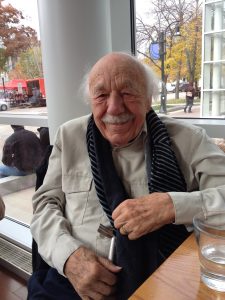
University of Wisconsin–Madison Professor Emeritus Willy Haeberli passed away October 4, 2021. He was 96.
Born in Zurich, Switzerland on June 17, 1925, Haeberli received his PhD from the University of Basel (Switzerland) in 1952. He joined the faculty of UW–Madison in 1956, retiring in 2005.
Haeberli was a world-class experimental nuclear physicist. His research focused on studying spin effects in nuclear processes and in fundamental interactions. He and his collaborators developed spin-polarized gas targets of atomic hydrogen and deuterium. These “Haeberli cells” were used in many experiments worldwide including the Indiana University Cyclotron Facility, Brookhaven National Laboratory, and DESY Laboratory in Germany, and they were crucial for the success of those experiments.
Haeberli was the Raymond G. Herb Professor of Physics and a Hilldale Professor. He was elected to the American Academy of Arts and Sciences and the National Academy of Sciences, and he won the American Physical Society’s Bonner Prize in nuclear physics in 1979.
In addition to his scientific achievements, Haeberli was an accomplished teacher. He taught physics courses at UW–Madison for 49 years and developed the popular course Physics 109: Physics in the Arts, with Prof. Ugo Camerini. Physics in the Arts has been offered successfully and continuously since 1969, and has been emulated by tens of universities across the country. In the last five years before retiring, he co-taught the course with Prof. Pupa Gilbert. After he retired, Gilbert convinced him to co-write a textbook for Physics in the Arts, published by Academic Press-Elsevier in 2008, and 2011, translated into Chinese and published by Tsinghua University Press in 2011.
“Willy is a giant in my life. He was career changing, life changing, teaching changing, everything. Just the most amazing person I could have ever met,” Gilbert says. “He was, until the last day, my best friend ever, and the closest thing to a father figure I have ever had.”
Gilbert says that Haeberli’s interest in Physics in the Arts may have stemmed from his musician days — he played the flute in a quartet in college — and his wife’s passion for the figurative arts. She continues:
He always loved a lot more the physics of sound compared to the physics of light and color. He and I had feisty disagreements about the physics of light, and I enjoyed every one of them. Very often before classes I would come up with questions, and he could always, always answer them and pacify me. The last one was last spring, when I was teaching sound, and started wondering: Okay, we know that the speed of sound changes dramatically with temperature, but does the frequency change too? In other words, does a tuning fork sound different indoors or outdoors in Madison’s winters? I looked into this seemingly trivial question and could not find any answer I could trust to be right. Until I asked Willy, who (of course!) knew the answer right away, and charmingly explained that the wavelength and the speed of sound vary with temperature for a guitar string or a tuning fork, but the frequency does not. I will miss these elegant answers tremendously!
Haeberli recently made a significant donation to the Ingersoll Physics Museum, which allows for new exhibits to be developed, allows for current exhibits to be improved, and helps fund the docents program which provides tours for visiting school groups. He and his late wife, Dr. Gabriele Haberland, also supported the Madison Museum of Contemporary Art, UW–Madison’s Chazen Museum, and Tandem Press with generous gifts.
Several current and emeritus department members shared their memories of Willy. Please visit the Willy Haeberli tribute page to read those stories. The Wisconsin State Journal also ran an obituary.
Many thanks to Profs. Pupa Gilbert and Baha Balantekin for helping with this obituary